Dangers of Flushing Cat Poop Down Your Toilet - Avoid Possible Issues
Dangers of Flushing Cat Poop Down Your Toilet - Avoid Possible Issues
Blog Article
On this page below you'll find lots of sensible facts in relation to Don’t flush cat feces down the toilet.

Introduction
As feline owners, it's important to bear in mind how we throw away our feline good friends' waste. While it may appear hassle-free to purge feline poop down the commode, this practice can have damaging repercussions for both the setting and human wellness.
Ecological Impact
Purging feline poop presents dangerous virus and bloodsuckers into the water system, posturing a considerable danger to marine environments. These contaminants can adversely impact aquatic life and compromise water top quality.
Health Risks
In addition to environmental worries, flushing pet cat waste can additionally posture wellness threats to human beings. Pet cat feces might have Toxoplasma gondii, a bloodsucker that can trigger toxoplasmosis-- a potentially severe illness, specifically for expecting women and people with weakened body immune systems.
Alternatives to Flushing
The good news is, there are much safer and more accountable ways to dispose of feline poop. Consider the complying with choices:
1. Scoop and Dispose in Trash
The most typical approach of getting rid of pet cat poop is to scoop it into a naturally degradable bag and toss it in the trash. Make sure to make use of a committed litter scoop and deal with the waste immediately.
2. Use Biodegradable Litter
Select naturally degradable feline trash made from materials such as corn or wheat. These litters are environmentally friendly and can be securely thrown away in the trash.
3. Bury in the Yard
If you have a yard, think about burying pet cat waste in a marked location far from vegetable yards and water sources. Make certain to dig deep sufficient to avoid contamination of groundwater.
4. Install a Pet Waste Disposal System
Buy an animal waste disposal system especially designed for feline waste. These systems make use of enzymes to break down the waste, reducing smell and ecological impact.
Final thought
Liable pet dog ownership extends beyond supplying food and sanctuary-- it additionally involves proper waste management. By refraining from flushing cat poop down the toilet and choosing alternate disposal methods, we can reduce our environmental impact and secure human health and wellness.
Why Can’t I Flush Cat Poop?
It Spreads a Parasite
Cats are frequently infected with a parasite called toxoplasma gondii. The parasite causes an infection called toxoplasmosis. It is usually harmless to cats. The parasite only uses cat poop as a host for its eggs. Otherwise, the cat’s immune system usually keeps the infection at low enough levels to maintain its own health. But it does not stop the develop of eggs. These eggs are tiny and surprisingly tough. They may survive for a year before they begin to grow. But that’s the problem.
Our wastewater system is not designed to deal with toxoplasmosis eggs. Instead, most eggs will flush from your toilet into sewers and wastewater management plants. After the sewage is treated for many other harmful things in it, it is typically released into local rivers, lakes, or oceans. Here, the toxoplasmosis eggs can find new hosts, including starfish, crabs, otters, and many other wildlife. For many, this is a significant risk to their health. Toxoplasmosis can also end up infecting water sources that are important for agriculture, which means our deer, pigs, and sheep can get infected too.
Is There Risk to Humans?
There can be a risk to human life from flushing cat poop down the toilet. If you do so, the parasites from your cat’s poop can end up in shellfish, game animals, or livestock. If this meat is then served raw or undercooked, the people who eat it can get sick.
In fact, according to the CDC, 40 million people in the United States are infected with toxoplasma gondii. They get it from exposure to infected seafood, or from some kind of cat poop contamination, like drinking from a stream that is contaminated or touching anything that has come into contact with cat poop. That includes just cleaning a cat litter box.
Most people who get infected with these parasites will not develop any symptoms. However, for pregnant women or for those with compromised immune systems, the parasite can cause severe health problems.
How to Handle Cat Poop
The best way to handle cat poop is actually to clean the box more often. The eggs that the parasite sheds will not become active until one to five days after the cat poops. That means that if you clean daily, you’re much less likely to come into direct contact with infectious eggs.
That said, always dispose of cat poop in the garbage and not down the toilet. Wash your hands before and after you clean the litter box, and bring the bag of poop right outside to your garbage bins.
https://trenchlesssolutionsusa.com/why-cant-i-flush-cat-poop/

I came across that content about Don’t flush cat feces down the toilet when browsing the internet. So long as you appreciated our blog posting if you please make sure you remember to share it. Thank-you for taking the time to read it.
Click Here Report this page